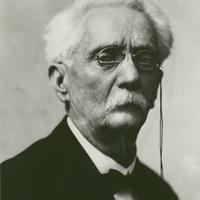Domènech i Montaner Anniversary
The figure of Domènech i Montaner is that of a humanist with a multifaceted artistic personality and a superlative social and country consciousness, reminiscent of Renaissance men. This year, as we commemorate the centenary of his death, we remember not only the well-known side of the architect who built the Palace, but also his musical affiliation with the great masters who also served as a guide to Lluís Millet, founder of the Orfeó: Bac , Beethoven and Wagner.
 Lluís Domènech i Montaner
Lluís Domènech i Montaner
Lluís Domènech i Montaner laid the foundations of Modernism in Catalonia and became the benchmark for architects who followed the current prevailing in the late nineteenth century; even of an unclassifiable genius like Antoni Gaudí.
With the Palau de la Música Catalana, he transcended the concept of concert hall prevailing until now to create an authentic architectural jewel, a Wunderkammer (room of wonders) in which Nature and symbolic references to music give meaning to a space flooded by natural light that hides an unattainable treasure, musical art.
Through the figures of Bach, Beethoven and Wagner, his favorite composers, we can better understand the musical universe that incited the emotions of Domènech i Montaner and that inspired the master to create the great palace of music that today hosts all musical manifestations.
CONFERÈNCIES
The Palau de la Música Catalana is more than a modernist building, it is a temple of music and a choir that has been beating for more than a hundred years in the cultural and social life of the city and the country. A monument capable of integrating other monuments in the form of historical facts, ideas and music. Three conferences in the Rehearsal Room of the Orfeó Català, where the first stone of the building is located, link the work of Domènech i Montaner with the intellectual and musical scaffolding of other geniuses.
No activity currently available
EXHIBITIONS
The Centre de Documentació de l'Orfeó Català is a centre specialising in musical documentation and the leading reference in all documentation that brings together the history of the Orfeó Català and the Palau de la Música Catalana. Due to the importance of its collection, it is considered one of the main musical centers created by a private civil entity in Catalonia. The CEDOC promotes the exhibitions at the Palace and on the occasion of the Year Domènech and Montaner presents a specific one for the anniversary.
Schedule
This 2023 marks the centenary of one of the most important architects of modernism, Lluís Domènech i Montaner. The Palau de la Música Catalana as one of the most emblematic buildings of the architect, will host an exhibition specially dedicated to the construction of the Palau de la Música Catalana and all its inspiring genius that culminated with the magnificent concert hall, unique in the world.
Domènech y Montaner brought together at the Palau all the arts of the modernist era from sculpture, stained glass windows or mosaics, but we also know that he was inspired by large international concert halls and foreign artists.
The centenary of 2023 is a reason to discover the Palau with all its dimensions, with a new revealing look that will help us discover the creative foundation of Lluís Domènech i Montaner.
ARCHITECTURAL AND HERITAGE VISITS
Beyond the regular guided tours and pounds with audio guide, the Palace emphasizes three types of special visits to approach the heritage from the creative workshop, the recreational component and a new telematic modality of entering the enclosure.
Performing activities
The Palau is a musical temple of reference and a space that embraces multidisciplinarity and miracles on the architectural and musical fact. Faithful to this openness, it invites artists from different scenes to rethink their heritage and the very idea of voice and song. Heterodox and experimental interventions that the fan a living entity.
No activity currently available
Links of Domènech i Montaner with concerts of the season
Domènech y Montaner was no stranger to the impact of Wagner's music in Barcelona; an energy that marked the cultural life of an entire city. For the architect, Wagner's work became a strong influence thanks to the early works of the composer (Lohengrin, Tannhäuser...), although later the admiration was diluted with the later works.
His links with Richard Strauss are also notable. Domènech y Montaner was strongly influenced by the bombing of Reims Cathedral during World War I and Strauss was inspired by the bombings of World War II to compose Metamorphoses. And both worked on the idea of metamorphosis in their works; thus, the architecture of the Palace is, also, a monument erected on ancient arts on which modern techniques were introduced.
Concerts related to Lluís Domènech i Montaner
No activity currently available
Family Programming
The Educational Service of the Palau continues to program the show Colors and more colors, premiered for the 110th anniversary of the construction of the Palau, aimed at families and schools, under the musical direction of Dani Espasa. On the occasion of the commemoration of the Year Domènech and Montaner, more sessions are scheduled and the recording of the show for Palau Digital is planned. On the other hand, Marc Timón has been commissioned to compose a musical clip to accompany an audiovisual animation about the architect.
In addition to this show, which is offered in schools and also to families, we also scheduled the session Visit and experience the Palau, a guided tour of the enclosure with experimental plastic activities (for children between 5 and 10 years old). At the same time, we offer several family visits throughout the year (also in Spanish, English and French) to tour the modernist site, with an interactive game through a digital application (more info at visits.palaumusica.cat)
No activity currently available
